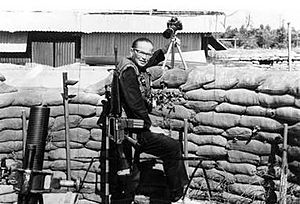Dickey Chapelle facts for kids
Quick facts for kids
Dickey Chapelle
|
|
|---|---|

Chapelle at the Don Phuc command post on the Vietnamese–Cambodian border, 1964
|
|
| Born |
Georgette Louise Meyer
March 14, 1918 Milwaukee, Wisconsin U.S.
|
| Died | November 4, 1965 (aged 47) near Chu Lai, Quang Ngai Province, South Vietnam
|
| Nationality | American |
| Alma mater | Massachusetts Institute of Technology |
| Occupation | Photojournalist |
| Years active | 1941–1965 |
Dickey Chapelle, born Georgette Louise Meyer (March 14, 1918 – November 4, 1965), was a brave American photojournalist. She was famous for reporting from war zones. Her work covered conflicts from World War II all the way through the Vietnam War. She captured important moments with her camera.
Contents
Early Life and Photography Beginnings
Dickey Chapelle was born in Milwaukee, Wisconsin. She went to Shorewood High School. When she was just sixteen, she studied airplane design at the Massachusetts Institute of Technology.
Later, she returned home and worked at a local airfield. She wanted to learn to fly planes, not just design them. Chapelle then moved to Florida to live with her grandparents. There, she wrote press releases for an air show. This led to a writing job in Havana, Cuba.
A story she wrote about an air show accident in Cuba caught the eye of an editor at Transcontinental and Western Air (TWA). This led her to move to New York City. While working at TWA, she started taking weekly photography classes. Her teacher, Tony Chapelle, became her husband in 1940. She later left her job to create a collection of her photos. She sold these photos to Look magazine in 1941. After fifteen years, she and Tony divorced. She then officially changed her first name to Dickey.
Becoming a War Correspondent
Even with limited photography experience, Dickey Chapelle became a war correspondent for National Geographic during World War II. One of her first big assignments was with the Marines. She covered the intense battle of Iwo Jima. She also reported from the battle of Okinawa.
After the war, she traveled the world. She often went to great lengths to cover stories in dangerous war zones. During the Hungarian Revolution of 1956, Chapelle was captured and held in jail for over seven weeks. She later learned to jump with paratroopers. She often traveled right alongside the troops.
Her bravery and dedication earned her many awards. She also gained the respect of both military members and other journalists. Chapelle was a small woman, but she was known for being tough. She always wore her signature uniform: military fatigues, an Australian bush hat, and Harlequin glasses. She also always wore pearl earrings.
Reporting from Vietnam and Final Days
Dickey Chapelle was a strong supporter of fighting against Communism. She openly shared these views at the start of the Vietnam War. In the early 1960s, her stories highlighted the American military advisors. These advisors were already fighting and dying in South Vietnam. She also wrote about the Sea Swallows, an anti-communist group.
Chapelle was killed in Vietnam on November 4, 1965. She was on patrol with a Marine group during a mission called Operation Black Ferret. This was about 16 kilometers south of Chu Lai, in Quang Ngai Province. Her last moments were captured in a famous photograph by Henri Huet. Her body was sent home with an honor guard of six Marines. She received a full Marine burial.
She was the first female war correspondent to be killed in Vietnam. She was also the first American female reporter to be killed in action.
Awards and Recognition
Dickey Chapelle received many honors for her courageous work:
- The Overseas Press Club's George Polk Award for excellent reporting from abroad.
- The National Press Photographers Association's 1963 award. This was for her photo of a Marine in Vietnam, which appeared in the Milwaukee Journal newspaper.
- The Distinguished Service Award from the U.S. Marine Corps Combat Correspondents Association.
Legacy and Memory
Dickey Chapelle's bravery and dedication are still remembered today:
- The Marine Corps League gives out the Dickey Chapelle Award every year. This award honors a woman who has greatly helped the morale and well-being of U.S. Marines.
- In 1966, a memorial was placed near where she died. It has a plaque that says: "She was one of us and we will miss her."
- Chapelle is featured in the 2011 documentary film No Job for a Woman: The Women Who Fought to Report WWII.
- The Milwaukee Press Club added Chapelle to their Hall of Fame in 2014.
- In 2015, Milwaukee PBS made a documentary about her called Behind the Pearl Earrings: The Story of Dickey Chapelle, Combat Photojournalist.
- In 2017, Chapelle was made an honorary Marine.
- The 2001 song Pearl's Eye View (The Life of Dickey Chapelle) by Nanci Griffith is about her.
- The first book about her life, Fire in the Wind: The Life of Dickey Chappelle, was published in 1992.
- Another book, First to the Front: The Untold Story of Dickey Chapelle, Trailblazing Female War Correspondent, was published in 2023.
See also
- List of journalists killed and missing in the Vietnam War

